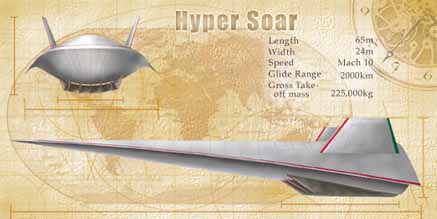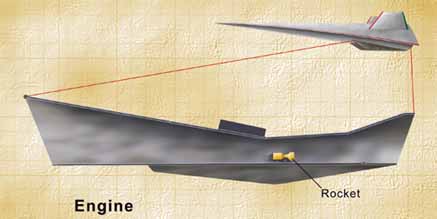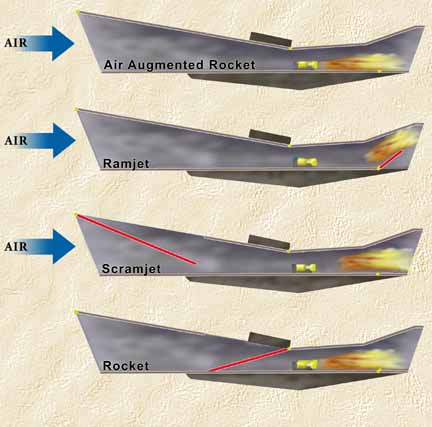





A Ride on the
Wild Side
Wild Side
An aerospace engineer has designed an airplane
that could fly at ten times the speed of sound by skipping off the top of the atmosphere.
But will it ever fly?
Illustrated by Shawn Gould

Nearly all great innovations seemingly must be preceded by prophets, men for the most part ignored or ridiculed, who have the vision to comprehend the implications inherent in a new discovery or a new innovation. Stating something novel, something that differs radically from what is currently believed, is dangerous business. It used to be common practice to feed such prophets a stout of hemlock brew, or simply burn them at the stake. In any period the role of the prophet is no life of joy.
- Stewart Holbrook, The Story of American Railroads
(Crown Publishers, NY, 1947)
It is the year 2040. High-speed monorails cut through the desolate Mojave Desert, carrying hurried travelers to and from a remote airport. The heat is shimmering over a couple of 10,000-foot-long runways. This is home base for a fleet of Mach 10 HyperSoars, the fastest airplanes ever built.
A silvery, wingless airplane shaped like a spearhead turns onto a two-mile runway for takeoff. Inside, business executives in designer suits fasten their suspender seatbelts and sit back. With an ear-splitting boom the aircraft lifts off the ground. Strict noise regulations have banned the noisy bird from airports near inhabited areas. The acceleration presses the 500 passengers of the 200-foot-long aircraft into their seats. HyperSoar quickly attains its cruising speed of 6,750 miles per hour--ten times the speed of sound--and after only five minutes reaches its maximum altitude at 200,000 feet, four times higher than the old Boeing 747s could ever go.
 Flying on the uppermost layer of the atmosphere,
HyperSoar shuts off its engines and starts a shallow,
free-falling glide. At a speed three times faster than that
of the old Concorde, the aircraft starts its characteristic
alternating boost and glide flight pattern. Like a rock on a
still lake surface, HyperSoar goes skipping along the
atmosphere, prompting Australians to call it the “Kangaroo.”
See flight animation.
At two-minute intervals, the engines propel the aircraft out
of the atmosphere before shutting off, as there is no air to
burn fuel with anyway. The triangular aircraft, designed for
gliding, then dips back into the atmosphere in a parabolic
curve like a roller coaster in slow motion. By rising into
the dead cold space void of air molecules, HyperSoar avoids
serious damage from the heat created by friction with the
air at such a speed. The passengers alternate between
free-floating in zero gravity and, during the acceleration
phase of the hop, being pressed back into their seats like a
kid on a swing. Just 1 hour, 15 minutes and 24 hops after
takeoff, HyperSoar glides the last 1,000 miles of its
journey and touches ground in the Australian desert.
Flying on the uppermost layer of the atmosphere,
HyperSoar shuts off its engines and starts a shallow,
free-falling glide. At a speed three times faster than that
of the old Concorde, the aircraft starts its characteristic
alternating boost and glide flight pattern. Like a rock on a
still lake surface, HyperSoar goes skipping along the
atmosphere, prompting Australians to call it the “Kangaroo.”
See flight animation.
At two-minute intervals, the engines propel the aircraft out
of the atmosphere before shutting off, as there is no air to
burn fuel with anyway. The triangular aircraft, designed for
gliding, then dips back into the atmosphere in a parabolic
curve like a roller coaster in slow motion. By rising into
the dead cold space void of air molecules, HyperSoar avoids
serious damage from the heat created by friction with the
air at such a speed. The passengers alternate between
free-floating in zero gravity and, during the acceleration
phase of the hop, being pressed back into their seats like a
kid on a swing. Just 1 hour, 15 minutes and 24 hops after
takeoff, HyperSoar glides the last 1,000 miles of its
journey and touches ground in the Australian desert.
Although an actual operational HyperSoar airplane is still decades away, if indeed it ever appears, the imagination of one man is working tenaciously to make this science fiction journey come true some day. Preston Carter, 42, has spent 10 years working late nights, and enduring discouraging criticism and his own nagging doubts to design the airplane that flies through his dreams at hypersonic speed.
In the summer of 1998, the space systems engineer at the Lawrence Livermore National Laboratory, California, presented the world with a concept that, in theory at least, overcomes all obstacles that have kept super-fast travel out of mankind’s reach. During the following months, the mass media eagerly took up the futuristic idea, which Carter dubbed HyperSoar (see breakout).
“HyperSoar catches people’s imagination,” Carter explains the hype.
Science News, September 12, 1998;
Space News, October 5, 1998;
Jane’s Defense Weekly, October 21, 1998;
Science News Online September 19, 1998
The numbers that flicker over Carter’s computer screen tell him that his creation would be the first hypersonic airliner that is both technically feasible and economically viable. Hypersonic means flying faster than Mach 5, five times the speed of sound. Everything between Mach 1 and Mach 5 is called supersonic. No airplane without rocket engines has yet reached that speed. The fastest fighter plane flies at Mach 3, and the Concorde manages just about Mach 2.
HyperSoar would not only be the fastest airplane ever, but would also be more efficient than anything flying, Carter claims. “It is truly efficient to go very fast," Carter says, although that may seem counterintuitive. The supersonic Concorde’s fuel use per weight transported is extremely inefficient, because its body consists mostly of wings. Believe it or not, HyperSoar would not have wings, but would instead be shaped like a wing. The spearhead shape, a so-called “waverider” design, is excellent for gliding even at low speeds of 120 mph during landing.
Because it has more room for cargo, HyperSoar could carry about twice as much weight as a Boeing 747. However, it also gobbles up about twice as much fuel, something that would not gain Carter support from environmental organizations. Because HyperSoar would go so fast, it could fly between opposite ends of the world about five times in the time it takes a conventional airplane to make the trip once. In sum, it could therefore transport about five times more cargo, which translates into a fivefold profit for the carrier.
Following that reasoning, HyperSoar would also make space access cheaper, Carter says. NASA’s space shuttles can only carry cargo equivalent to 2 percent of their own weight. HyperSoar could carry five times more, he claims. In addition, HyperSoar could return with more cargo immediately, whereas the Space Shuttle needs a few months of preparation, he says.
Carter’s interest in space flight runs in the family. His father was an aerospace engineer for the Apollo space program at Boeing and for a hypersonic rocket airplane project at NASA in the 1960’s. The plane, first called DynaSoar, was supposed to use the same skipping flight path as HyperSoar, but the project, later renamed Dinosaur, was killed before it was ever built.
As a kid, Carter lived in communities with space programs all over the country. He remembers looking up into the night sky, admiring everything that could fly through space.
“I passionately love doing this [designing HyperSoar],” he says. “It’s what I wanted to do as a kid.”
Besides working on the HyperSoar design, Carter is engineering spacecraft technology at Lawrence Livermore National Laboratory, a place that, among other things, designs nuclear weapons. His work included co-founding a lunar mission and designing heat-stable spacecraft coating.
Carter who used to race motorbikes in college, received his master’s degree in aerospace engineering from the University of Texas, Austin. After graduate school he worked for the Mars lander group at Lockheed Martin and for Space Industries in Houston, where he designed heat-tolerant materials and space experiments.
It takes Carter only a few minutes to drive his old army Jeep to his home in Livermore, where he lives with his wife, Nancy, and two children, Albert, 9, and Cathy, 6. Nancy is also an engineer, which Carter says makes her more prepared to put up with his working overtime.
Carter sometimes wonders whether he is going to waste his life investing in this idea. But then he tells himself he’s got to believe in it. He sees himself nurturing his adventurous project for the next 10 years to make sure it does not deteriorate into mediocrity, he says.
The idea of a hypersonic cruising airplane skipping along the atmosphere came to life 11 years ago in a coffee room at Lockheed’s headquarters in Houston. Sitting over steaming cups of sweet, creamy coffee, Carter and his college friend Ron Humble, now an aerospace engineer at the U.S. Air Force Academy, discussed a question that bugged them: why was space flight so expensive? They realized the answer was a catch-22: It was expensive because there was no commercial market, and there was no market because it was so expensive.
Carter and Humble thought the international fast freight market would be the perfect candidate to profit from an airplane that could deliver goods from Los Angeles to Tokyo in two hours. In 1988, they calculated the performance of a skipping hypersonic airplane and sent a letter to Federal Express. Only a week later, the company’s CEO, Fred Smith, called Carter back. He said Federal Express was “extremely interested” in hypersonic airplanes for the small-package business but had no funds for such a project just then. FedEx had been negotiating to buy some surplus Concordes, but the French government had informed the company that hauling mail would besmirch the image of France’s national flag. Smith encouraged Carter and Humble to keep working on the hypersonic airplane idea.
Initially, Carter worked on the concept in his spare time, resisting the temptation of his fishing rods on weekends, while Humble went on to other projects. For the first six years he had no idea if he would run into a dead end, because it seemed too difficult to solve all the technical problems hypersonic flight posed. But by 1994, technologies such as hypersonic engines and heat-stable materials had advanced to the point that the HyperSoar concept might be possible. Carter’s boss at the Lawrence Livermore National Laboratory, Mark Eckert, encouraged him to keep working on it.
Lacking hard data, Carter did not publish any papers on the technical feasibility of HyperSoar. In November 1998, however, the respected Journal of Aircraft printed the first of a series of papers on the performance of a hypersonic airplane using a skipping trajectory that Carter had submitted. These theoretical papers were well received, according to Carter, but they assume that all the technology would be available.
For now, HyperSoar is only flying through the circuits of Carter’s office computer. According to his flight path analysis, the aircraft would have to rise to the upper atmosphere to an altitude of 40 miles. During a single parabola, in which it would glide without engines, HyperSoar would cover a distance of 250 miles and lose almost 20 miles in height. Animation. It would then fire its engines and rise again. It could reach Tokyo from LA in about 24 cycles.
Although Humble predicts that traveling on HyperSoar “would be quite a wild ride,” Carter argues that the skipping would be much smoother than a roller coaster ride. He thinks many people would rather ride in a HyperSoar for 1_ hours than sit in a commercial airliner for 12 to 16 hours.
However, it may not be entirely harmless to be without gravity for two minutes, as experiences with the “vomit comet,” NASA’s zero gravity plane KC-135 that trains astronauts have shown. One rider said in a CNN live report that “it was kind of like being on a roller coaster going over the top when your stomach jumps to the top... but on the KC-135, it never came down.” To be fair, it must be said that the KC-135 drops at the much steeper angle of 45 degrees instead of HyperSoar’s 2.8 degrees.
There are two big technical problems that a hypersonic airplane would face. Hypersonic flight a hard nut to crack for engineers because of the incredible heat that the aircraft must face while cutting through the atmosphere at this speed. At Mach 10, the air in front of the plane is compressed by the travel speed and heats up to more than 1600° Celsius, a temperature that can melt iron. HyperSoar would avoid excessive heating by bouncing into the cold of space.
Although engineers know how to make materials that can withstand the heat, some instruments or other parts of the aircraft could fail. Until the first successful flight tests, Carter is cautious about HyperSoar’s heat tolerance. In early test flights of the fighter plane Blackbird, used in the Gulf War, the hydraulic fluid started boiling and the rubber tires melted at Mach 3. HyperSoar will profit from lessons learned in such earlier attempts to fly fast.
The second big challenge is building engines that function at hypersonic speed. A new generation of engines combining rocket and air-breathing technology could solve this problem. The so-called Rocket-Based Combined-Cycle engine is a hollow tube that sucks in air and contains mechanisms that can burn fuel at different speeds.

A rocket accelerates the plane until it is flying at the speed of sound. The engine then switches to a ramjet, an air-breathing engine used by supersonic fighter planes, which slows down the air enough to burn the fuel within the tube. At hypersonic speed, over Mach 5, the air gets pressed so hard against the front of the airplane that it heats up the oxygen particles to the point they start falling apart. This is why until now only rockets, which carry their own oxygen in huge tanks, could reach this speed. The newest engine part, a so-called air-breathing scramjet, will be able to burn fuel at supersonic speed.

NASA will start testing such engines in flight next year (2000) (see NASA’s HyperX website).
The idea of a skipping airplane has been around since World War II, when a German engineer had an idea for a rocket-propelled bomber that could be boosted up to the Earth’s orbit, fly hopping off the atmosphere, and drop bombs on New York.
No airplane has yet used a skipping flight path, however. Only the Apollo capsule bounced off the atmosphere once to slow down before reentering the atmosphere. Carter was the first to think about a hypersonic, cruising airplane with jet engines that would use such a flight course.
But when he told his colleagues about a hopping plane, they thought he was out of his mind. The concept of a hypersonic cruising airplane was an old idea with a bad track record. NASA sunk $160 million into such a project, which proved too ambitious. After the project was cancelled in 1994, a NASA website called hypersonics “one of the greatest aeronautic research challenges.”
But significant advances in aerodynamics, engine design, and heat-stable materials make the HyperSoar idea now appear technically feasible.
Aerospace engineering circles learned of HyperSoar last summer, when a reporter discovered the HyperSoar design at an air show and wrote about it in the in September issue of the aeronautics journal Aviation Week & Space Technology. Many engineers slapped their foreheads: this was the design that could make hypersonic flight a reality &endash; given that none of the other technology would fail.
“It’s unlike anything we’ve ever built before. It’s pushing the limits of untested technology,” says Mark Lewis, an aerospace engineer at the University of Maryland who used to collaborate with Carter on earlier stages of the HyperSoar concept.
Carter’s college friend Ron Humble says it’s nothing magical. “But if it works, it’s a breakthrough.”
Space engineers cautioned that the technology was not advanced enough yet, but they did not say that HyperSoar was technically impossible, Carter said.
With one significant exception. NASA engineers working on Hyper-X, the airplane to test the air-breathing combo engines, did some tests and calculations of their own after hearing about HyperSoar. They concluded that HyperSoar could not work, Lewis says.
Lewis claims that NASA used a completely different aircraft and the wrong trajectory for their tests. He has published many theoretical papers on computer models that test the properties of hypersonic vehicles. He used to work for NASA, and says they may have a political interest in debunking HyperSoar. The NASA engineers did not want to comment on HyperSoar.
Carter would like to collaborate with NASA because they have the most know-how about hypersonic airplanes. He says they fight him because “the publicity of HyperSoar rains on their parade.”
For Carter, the publicity–and increasing acceptance–of his design means that funding for a prototype may be within reach. If someone gave him $500 million right now, he could have a one-third-scale prototype hopping on the atmosphere in only four or five years. The first commercial freight carriers could be flying in eight to 10 years.
This multibillion-dollar project is too big for one agency to finance. Carter has considered asking Boeing, Lockheed Martin, and Northrop Grumman to help fund his research. Carter would also like to see a collaboration of Livermore, NASA, and the U.S. Air Force. Together, these three agencies combine state-of-the-art heat-stable materials, aerodynamic expertise, and flight-testing centers. Carter predicts that the military would be quite interested in an ultra-fast airplane for reconnaissance or as a bomber capable of dropping huge loads of bombs.
Private venture capitalists are also eager to tap into the intercontinental express-transportation market. If hypersonic flight came true, the value of the fast freight market is expected to grow from today’s $12 billion to more than $150 billion over the next decade, according to a report about FedEx in Fortune Magazine in 1997.
As the HyperSoar idea is taking shape, Carter is not the only one pondering the possibilities of affordable space flight. A team of visionaries at NASA has thought up all sorts of ideas on their website. In the future, you may be able to pick up a video from a digital movie satellite, watch “Microgravity Games” held in space, or deliver organs for transplantation all over the world. We could dump our nuclear waste on the far side of the moon, book a “zero-gravity” joyride, or exploit extraterrestrial minerals.
But even if HyperSoar can overcome the substantial technical difficulties, it may not catch on as an airliner. Travelers might object to a roller-coaster type of long-distance transportation in which they’re hanging over their air-sickness bag for an hour and a half. Passengers demand a high level of comfort on a flight—even today many prefer regular airplanes over the fast but crammed and uncomfortable Concorde, says Carter’s collaborator Mark Lewis.
For adventurous people, however, it may be just the ride they’ve been looking for. Carter imagines that they could experiment with weightlessness in a zero-gravity lounge—a large, padded room. Food and drink would arrive in special containers via conveyor belt. In the weightlessness, HyperSoar could unnoticeably turn upside down and reveal a breathtaking view of the blue-green planet.
Engineers and visionaries alike have been intrigued by hypersonic flight for more than 50 years. Their curiosity may bring HyperSoar to life. For many decades to come, the Mojave Desert will remain silent, the oven-dry air shimmering over the gray dust. But someday, bulldozers may move in and cut through the soil and the silence, transforming the venerable wasteland into the runways of an ultra-modern HyperSoar airport.
“HyperSoar is the next-century equivalent of the airplane,” Carter muses.
- BIOs
- WRITER Beate Kittl
- Diplom (B.A.), University of Basel, Switzerland; M.A. equiv., Simon Fraser University, Canada.
Internship: Discover magazine, New York.
- ILLUSTRATOR Shawn Gould
- B.A., biology/pre-medical illustration, Iowa State University, 1998.
Internship: National Geographic magazine.
Text © 1999 Beate Kittl
Illustrations © 1999 Shawn Gould